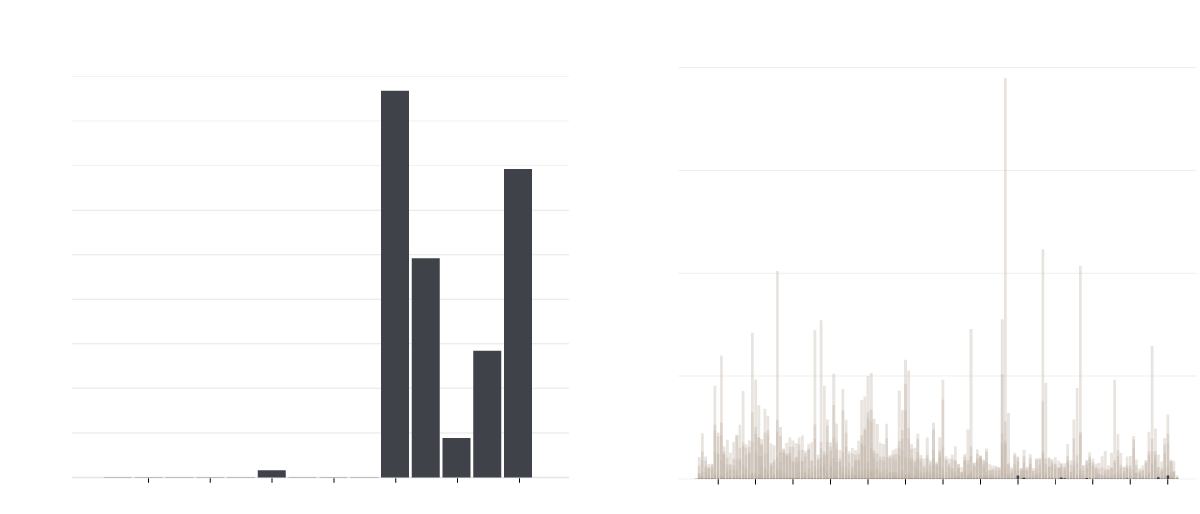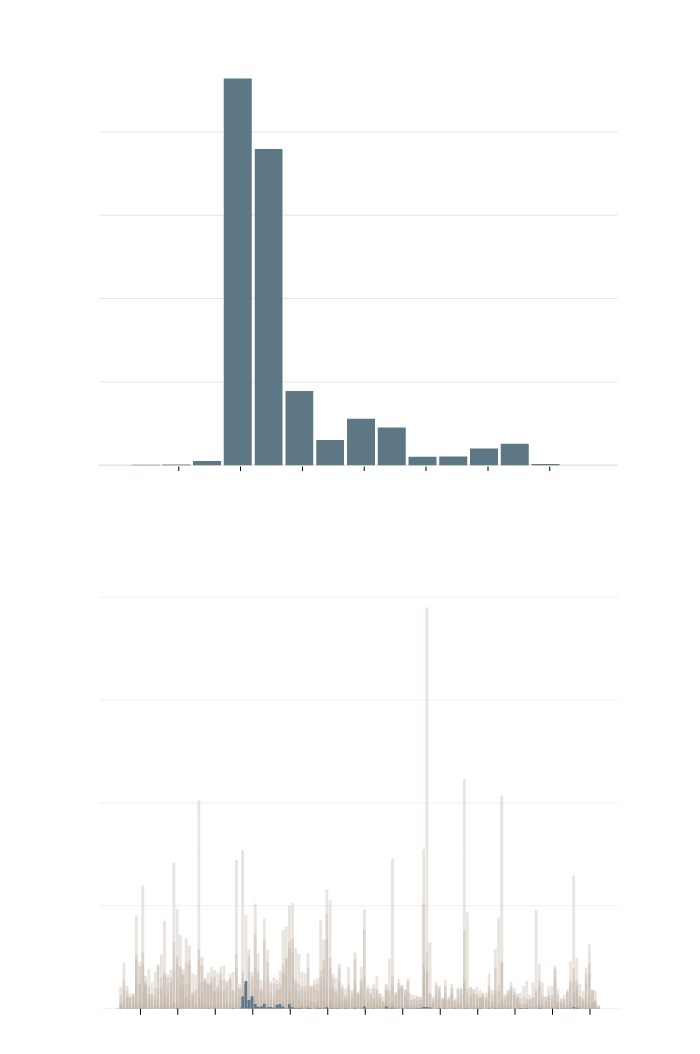The Rise and Fall of Weather Terms
Snow is on the decline. Polar vortex is on the rise. Gustnado is a distant memory.
Yearly count of 15-second segments using a weather-related term by CNN, Fox News, or MSNBC
Storm
Weather
Snow
Rain
Flood
Heavy Rain
Superstorm
Heavy Snow
Flurry
Freezing Rain
Thunderstorm
Polar Vortex
Sleet
Noreaster
Deluge
Bomb Cyclone
Dust Devil
Firenado
Gustnado
Rain Shower
Rainfall
Rainstorm
Snow Shower
Snow Squall
Snowmaggeddon
Snowpocalypse
Sun Shower
Thundersnow
Source: TV News Archive
The terms the major networks (CNN, Fox News, and MSNBC) use to describe weather events have had their ups and downs over the years.
As the world embraces the inevitability of climate change, most of us can expect more drastic weather events and with it more dramatic terminology. However, these dramatic terms also come as news networks compete for viewers’ attention and the marketing of these events becomes about increasing KPI’s as well as conveying the latest updates.
In 2014, a number of scientists were up in arms over the Weather Channel’s decision to name storms, which many felt was a marketing choice over a scientific one.
“I'm sorry, but naming winter storms is a meteorological disgrace and only leads to confusion,” wrote meteorologist Steven DiMartino. Similarly in 2020, some criticized the network’s branding of a hurricane during the pandemic as “COVIDCANE 2020”.
More recently, a number of pieces and op-eds have been written on the increase in dramatic terms used by outlets. Jim Duncan from The Washington Post wrote in February, “over the past few years, an onslaught of frightening-sounding weather words and phrases has accompanied nearly every major weather happening.” Another columnist from the Toronto Star wrote, “Stop with the ‘bomb cyclones’ and the ‘thundersnow’ — the world is scary enough without alarmist weather words.”
I wondered whether these observations were rooted in reality or possibly just recency bias after the latest storm coverage. In an analysis of data from the TV News Archive, I looked at how three major networks — CNN, Fox News, and MSNBC have described weather events since June 2009. Out of 28 terms describing the weather, some trends rose to the surface.
Weather terms used by major networks varied across seasons and years

Source: TV News Archive
Overall, more generic terms such as snow and rain have generally declined from 2010 to April 2022 though there are unsurprisingly seasonal rises and falls.
This decline in coverage seems independent of actual weather patterns as the annual national average of U.S. precipitation peaked in 2015, 2018, and 2019 over the same period according to the National Oceanic and Atmospheric Administration (NOAA).
The use of "Snow" overall declined since 2009

Count of 15-second segments using the term yearly
In comparison to other weather terms monthly
20,000
20,000
15,000
15,000
10,000
10,000
5,000
5,000
0
0
2010
2012
2014
2016
2018
2020
2022
2010
2011
2012
2013
2014
2015
2016
2017
2018
2019
2020
2021
2022

Count of 15-second segments using the term yearly
In comparison to other weather terms monthly
20,000
20,000
15,000
15,000
10,000
10,000
5,000
5,000
0
0
2010
2012
2014
2016
2018
2020
2022
2010
2012
2014
2016
2018
2020
2022

Count of 15-second segments using the term yearly
20,000
15,000
10,000
5,000
0
2010
2012
2014
2016
2018
2020
2022
In comparison to other weather terms monthly
20,000
15,000
10,000
5,000
0
2010
2012
2014
2016
2018
2020
2022
Source: TV News Archive
More descriptive and less frequently used phrases such as “heavy rain” and “snow shower” have declined more sharply.
Inversely, terms like bomb cyclone and polar vortex have been mentioned more frequently in recent years though still dwarf in comparison to common terms like snow and rain or even heavy rain. Due to a blizzard in January, bomb cyclone was used in 173 15-second blocks across the three networks so far this year, which is not too far behind the historically more popular term nor’easter at 223.
"Bomb Cyclone" joined the network's lexicon with storm coverage in Jan. 2018

Bomb Cyclone
Count of 15-second segments using the term yearly
In comparison to other weather terms monthly
20,000
200
200
15,000
150
150
10,000
100
100
5,000
50
50
0
0
0
2010
2012
2014
2016
2018
2020
2022
2010
2011
2012
2013
2014
2015
2016
2017
2018
2019
2020
2021
2022

Bomb Cyclone
Count of 15-second segments using the term yearly
In comparison to other weather terms monthly
20,000
200
200
15,000
150
150
10,000
100
100
5,000
50
50
0
0
0
2010
2012
2014
2016
2018
2020
2022
2010
2012
2014
2016
2018
2020
2022

Count of 15-second segments using the term yearly
200
200
150
150
100
100
50
50
0
0
2010
2012
2014
2016
2018
2020
2022
In comparison to other weather terms monthly
20,000
15,000
10,000
5,000
0
2010
2012
2014
2016
2018
2020
2022
Source: TV News Archive
Some terms have become synonymous with consequential weather events in history such as superstorm and snowmageddon, which have sharp increases and then trail off in the years following. Superstorm, in particular, jumped significantly during coverage of Hurricane Sandy in the fall of 2012 and has lingered since.
Hurricane Sandy coverage caused the term "Superstorm" to surge

Count of 15-second segments using the term yearly
In comparison to other weather terms monthly
20,000
2,000
15,000
1,500
10,000
1,000
5,000
500
0
0
2010
2012
2014
2016
2018
2020
2022
2010
2011
2012
2013
2014
2015
2016
2017
2018
2019
2020
2021
2022

Count of 15-second segments using the term yearly
In comparison to other weather terms monthly
20,000
2,000
15,000
1,500
10,000
1,000
5,000
500
0
0
2010
2012
2014
2016
2018
2020
2022
2010
2012
2014
2016
2018
2020
2022

Source: TV News Archive
Naming storms in this way is not new. Dubbed the Knickerbocker Storm, reporting from January of 1922 described a “million dollar snowstorm” that forced the Knickerbocker Theatre’s roof to collapse and the name to stick. In more recent years media outlets have labeled storms “snowzilla” or “snowpocalypse”.
In February 2010, one of the snowiest days on record in D.C. earned the name Snowmageddon. The Washington Post used a slew of terms to describe snowstorms around that time— snowpocalypse, snoverkill, and snow bonanza.
"Snowmageddon" soared in 2010 but has been adopted on occasion since

Count of 15-second segments using the term yearly
In comparison to other weather terms monthly
20,000
105
90
15,000
75
60
10,000
45
30
5,000
15
0
0
2010
2012
2014
2016
2018
2020
2022
2010
2011
2012
2013
2014
2015
2016
2017
2018
2019
2020
2021
2022

Count of 15-second segments using the term yearly
In comparison to other weather terms monthly
20,000
105
90
15,000
75
60
10,000
45
30
5,000
15
0
0
2010
2012
2014
2016
2018
2020
2022
2010
2012
2014
2016
2018
2020
2022

Count of 15-second segments using the term yearly
90
60
30
0
2010
2012
2014
2016
2018
2020
2022
In comparison to other weather terms monthly
20,000
15,000
10,000
5,000
0
2010
2012
2014
2016
2018
2020
2022
Source: TV News Archive